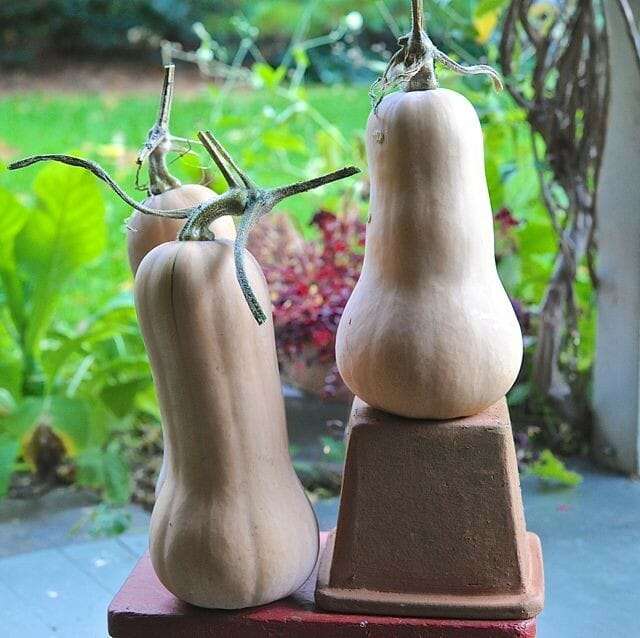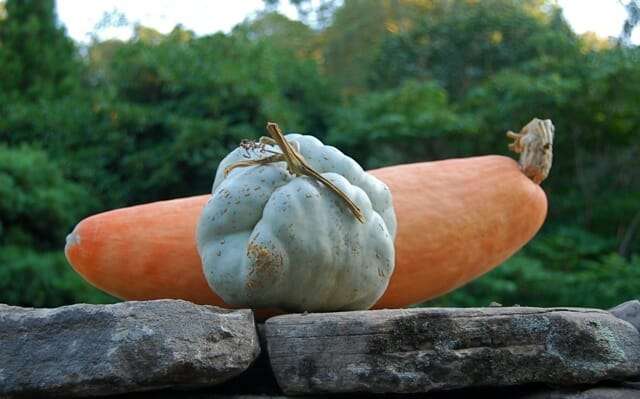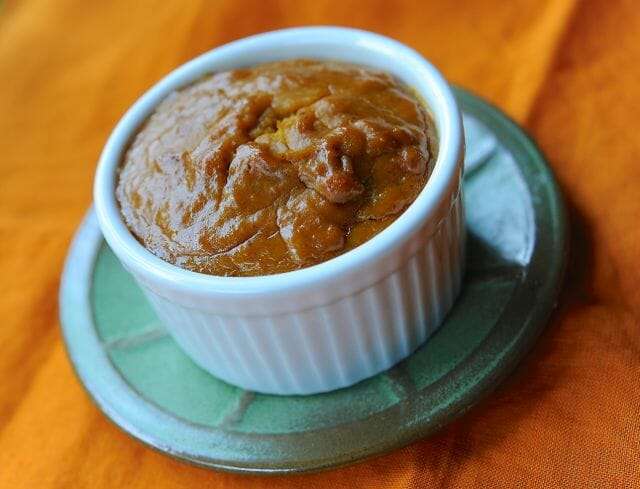how to solve the feared canned-pumpkin shortage (adopt a squash!)

Since then, it’s all about: Stock up or be left pumpkin-less! (Haven’t I heard this before? It’s nearly the same story as this one from the “Los Angeles Times” in 2009, even quoting the same Libby’s spokesman.)
How about this D.I.Y. remedy: Go buy a couple of ‘Butternut’ squash at the farmers’ market (or the supermarket, even) and make filling, putting extra batches of cooked, pureed “pumpkin” in the freezer while you’re at it to satisfy subsequent craving–or for use in soup or bread or gnocchi.

Meaning: Don’t try it with a pumpkin, as in Jack-o-lantern-shaped squash (unless perhaps you grow it yourself, and it’s the 1893 favorite ‘Winter Luxury,’ which squash expert Amy Goldman gives her top rating for pie-making). The word pumpkin has culinary significance, but is basically meaningless botanically speaking. They’re all squash.
Halve your chosen variety, scoop out the seeds and bake it, face-down, until it softens. Placing parchment paper between the flesh and the pan surface will make cleanup easier. I like to use big Pyrex pans, and add a little water at the start. Once cooked, cool the squash enough to be handled, and scoop the cooked flesh from the skin. Puree it. I use an immersion blender because I do large volumes at one time, but a food processor is probably more thorough, and ample for a pie or two’s worth.
Again: Make enough to freeze. A can of store-bought pumpkin contains 15 ounces of puree, and most pie recipes call for about 2 cups; choose the appropriate container for ease of use later. I use straight-sided, wide-mouth pint canning jars, leaving enough headroom for the puree to expand when freezing.
No freezer space? Just adopt a few hefty ‘Butternut’ with their stems still on (they keep better than stemless) to stash for later use. Ideal storage conditions for winter squash, once cured, are moderately warm and dry: 50-60 degrees F and 60-70 percent relative humidity. The bottom shelf of my pantry closet is currently cheek-to-jowl with the precious darlings. No shortage of pie filling here.






Don’t forget the lowly sweet potato, makes great “pumpkin” pies.
I make my own filling and freeze every year! Last year I found a local landrace farmer that has selected for the sweetest buttercup for years. I saved seeds from his crop and planted. My own crop is curing now; I can’t wait to keep adapting to my own yard! For more savory uses I add a little butternut puree that I freeze in smaller quantities.
This season I tried growing butternut squash for the first time. I grew just a couple of plants and have harvested a few squash. I am looking forward to using them through out the winter. Thank you for the suggestions, no worries for ‘shortages’ for us!
I had a bumper crop of sweet potatoes this year so we’ll be having sweet potato pie instead of pumpkin this year :)
Your timing could not be better !!!
Just checking out all the great/interesting pumpkin recipes…
Very disappointed that all called for ‘canned’ pumpkin.
I must have been 1/2 asleep …
I have so many winter squash from my “CSA” share.
Enough for now and to freeze for later.
Now to find the time.
We are still trying to get all the apples done.
Thank you for such a great web site !
You are welcome, Marcia. I just pop some in the oven when I am sitting here doing something else nearby, as it’s almost no prep time (just baking time). Enjoy!
THIS is valuable information!!!
Don’t forget the classic Long Island Cheese Pumpkin. I grew up with my mother making pies from them. Then the truck gardens on Staten Island were “developed” into a mall and I thought they were lost forever. I found them again here in Berkshire County and I’m growing my own – I’ve got three 12-14 pounders on display!
Thanks, James. I have used those, too (but haven’t grown them myself on a long time). Sounds like you are doing well with them indeed.
This article, the pictures, and the comments are delightful – plus it’s fun to see that an artificial ‘shortage’ will simply be ignored, because a lot of cooks are going to discover that both winter squashes and sweet potatoes make better, richer, tastier pies than any variety of pumpkin I’ve ever used. For those not afraid of occasionally using fats, try using cream in the pie filling recipe instead of evaporated or condensed milk. Both of those have a strong taste of their own that takes attention away from the rich squash/sweet potato flavor. 2 or 3 tablespoons of cornstarch added to the regular recipe guarantees that when baked, it will set into a lovely thick filling that can be cut easily and neatly. HTH.
I agree, Elaine — UGH to those fake processed dairy substitutes.